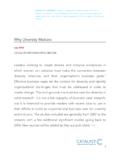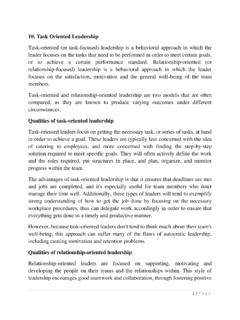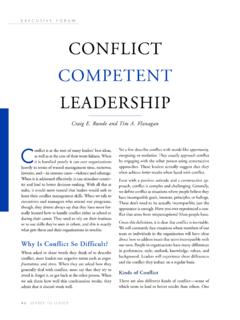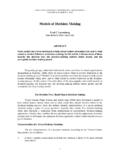Transcription of STOPPING - Catalyst.org
1 AY. WRONG WAY. G W. WRON. STOP O N LY. NO. STOPPING . ANY. TIME. The Double-Bind Dilemma for Women in leadership : Damned if You Do, Doomed if You Don't ABOUT CATALYST. Catalyst is the leading research and advisory organization working with businesses and the professions to build inclusive environments and expand opportunities for women at work. As an independent, nonprofit membership organization, Catalyst conducts research on all aspects of women's career advancement and provides strategic and web-based consulting services globally. With the support and confidence of member corporations and firms, Catalyst remains connected to business and its changing needs. In addition, Catalyst honors exemplary business initiatives that promote women's leadership with the annual Catalyst Award. With offices in New York, San Jose, Toronto, and Zug, Catalyst is consistently ranked No.
2 1 among nonprofits focused on women's issues by The American Institute of Philanthropy. The Double-Bind Dilemma for Women in leadership : Damned if You Do, Doomed if You Don't Exclusive Sponsor: IBM Corporation 2007 by CATALYST. NEW YORK 120 Wall Street, 5th Floor, New York, NY 10005-3904; (212) 514-7600; (212) 514-8470 fax SAN JOSE 2825 North First Street, Suite 200, San Jose, CA 95134-2047; (408) 435-1300; (408) 577-0425 fax TORONTO 8 King Street East, Suite 505, Toronto, Ontario M5C 1B5; (416) 815-7600; (416) 815-7601 fax ZUG c/o KPMG Fides, Landis+Gyr-Strasse 1, 6300 Zug, Switzerland; +41-(0)44-208-3152; +41-(0)44-208-3500 fax email: Unauthorized reproduction of this publication or any part thereof is prohibited. Catalyst Publication Code D68; ISBN#0-89584-265-3. ALSO BY CATALYST. Women Take Care, Men Take Charge: Stereotyping of Business Leaders Exposed (2005).
3 The first in a series on stereotyping, this report examined perceptions of women's and men's leadership among very senior managers more than 30 percent of study participants were CEOs. The study showed that managers perceived that there were in fact distinct differences between women and men leaders. For example, respondents both women and men perceived that more women leaders than men leaders were effective at caretaker behaviors such as supporting others and rewarding subordinates. However, they perceived that more men leaders than women leaders were effective at take charge behaviors such as delegating and problem-solving. Notably, the study finds these perceptions are not supported by research on actual leadership behavior, which finds that gender is not a reliable predictor of how a person will lead. This study was conducted in collaboration with Theresa Welbourne, , at the Ross School of Business, University of Michigan.
4 Different Cultures, Similar Perceptions: Stereotyping of Western European Business Leaders (2006). The second report in the series on stereotyping examined perceptions of women's and men's leadership among Western European managers. The study compared managers' perceptions from four groups of culturally similar countries Anglo (United Kingdom, United States), Germanic (the Netherlands, Germany), Latin (France, Italy, Spain), and Nordic (Denmark, Norway, Sweden) and found that in every group managers held stereotypic perceptions of women's and men's leadership . Further, the findings of this research suggest that these perceptions bear some striking similarities across cultures. Importantly, in some cultures, stereotypic perceptions discredited the effectiveness of women leaders at highly valued leadership attributes. COMING SOON FROM CATALYST.
5 The fourth addition to the series on stereotyping will focus on practices for combating stereotypic bias. As indicated in the previous studies in the series, stereotypic perceptions of women's and men's leadership are pervasive both in the United States and Western Europe and have significant potential to undermine women leaders. However, because stereotypic bias is often difficult to detect, removing this critical barrier to women's advancement is a considerable challenge for organizations. This study will offer direction for organizations on how to meet this challenge focusing specifically on human resources practices. In particular, the study will explore how performance evaluation processes can be structured to minimize gender bias and enable organizations to tap the best leadership talent both women and men. TABLE OF CONTENTS. Foreword: A Punishing Dilemma 1.
6 Chapter 1: Introduction and Key Learnings 3. Chapter 2: Men as Default Leaders 9. Chapter 3: Polarized Perceptions (Predicament 1) 13. Chapter 4: Higher Standards but Lower Rewards 16. (Predicament 2). Chapter 5: Competent but Not Liked (Predicament 3) 19. Chapter 6: Stereotypes and Women's Double Bind: 22. Individual and Organizational Strategies Chapter 7: Introduction to Catalyst's Stereotypes 31. Diagnostic Instrument Acknowledgments 35. Appendix 1: Study Methodology 36. Appendix 2: Construction of Catalyst's Stereotypes 39. Diagnostic Instrument Catalyst Board of Directors FOREWORD: A PUNISHING DILEMMA. Double bind n (1) A psychological impasse created when contradictory demands are made of an that no matter which directive is followed, the response will be construed as incorrect. (2). A situation in which a person must choose between equally unsatisfactory alternatives; a punishing and inescapable We all know the feeling of being trapped in a double bind that nagging sense that whatever you do, you can do no right.
7 Few know what that feels like more than women in corporate management. As Catalyst research confirms, despite the numerous business contributions of women leaders, men are still largely seen as the leaders by default. It's what researchers call the think-leader-think-male . As atypical leaders, women are often perceived as going against the norms of leadership or those of femininity. Caught between impossible choices, those who try to conform to traditional , masculine leadership behaviors are damned if they do, doomed if they don't. Gender stereotypes can become a powerful yet invisible threat to women leaders and the organizations in which they work and lead. The impact of stereotypic bias is often underestimated. Some argue that stereotypes must reflect real differences in the behavior of men and women, or else they would not exist.
8 But research shows that stereotypes do not accurately represent reality; they misrepresent Others might argue that belaboring the issue of stereotypes dilutes the focus from inroads already forged. But that progress has been remarkably slow. How can individuals and companies accelerate the closing of the corporate leadership gap? No matter how high women's levels of preparation and aptitude for corporate leadership roles, no matter how many women are promoted, if companies fail to acknowledge and address the impact of stereotypic bias, they will lose out on top female talent. By creating a false dichotomy between men's and women's characteristics, stereotypes narrow the range of effective behaviors within the workplace overall. 1. The American Heritage Dictionary of the English Language, Fourth Edition. (Boston, MA: Houghton Mifflin, 2000).
9 2. Crystal Hoyt, Women Leaders: The Role of Stereotype Activation and leadership Self-Efficacy, Kravis leadership Institute leadership Review (Fall 2002) ; Virginia E. Schein, A Global Look at Psychological Barriers to Women's Progress in Management, Journal of Social Issues, vol. 27, no. 4 (Winter 2001): p. 4-13; Sabine Sczesny, A Closer Look beneath the Surface: Various Facets of the Think-Manager-Think-Male Stereotype, Sex Roles, vol. 49, no. 7/8 (October 2003): p. 353-363. 3. Through the extensive research on gender differences and similarities, we learn that women and men are actually more similar than different and that there is more variation within each group (women and men) than there is between women and men. See, for example, Janet S. Hyde, The Gender Similarity Hypothesis, American Psychologist, vol. 60, no. 6 (September 2005): p.
10 581-592; Elisabeth Aries, Men and Women in Interaction: Reconsidering the Differences (New York: Oxford University Press, 1996). The Double-Bind Dilemma for Women in leadership : Damned if You Do, Doomed if You Don't 1. In today's globally competitive marketplace, organizations cannot afford to underutilize any segment of the talent pool, nor place constraints on what counts as effective behaviors. To ensure that vital leadership talent is effectively assessed and deployed, companies must address stereotypic bias head on. We believe that organizations can help change how women leaders in their organizations are perceived. Through qualitative analyses of women and men managers' open-ended comments and in-depth interviews, we document the predicaments women leaders face, expose the stereotypes that create the double bind, look at the strategies successful women leaders use to deal with these stereotypes, and offer a tool for organizations to build awareness of how stereotypes influence work outcomes.











